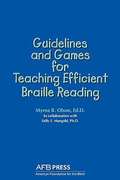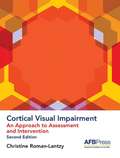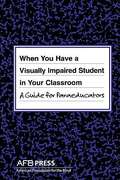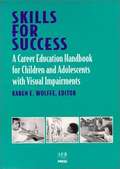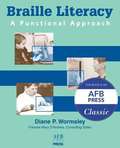Special Collections
American Foundation for the Blind
Description: American Foundation for the BlindPress offers a wide range of information for students, professionals, researchers, and blind and visually impaired people and their families. #teachers #disability
- Table View
- List View
Guidelines and Games for Teaching Efficient Braille Reading
by Sally S. Mangold and Myrna R. OlsonThese unique guidelines and games provide ideas for adapting a general reading program to the needs of braille readers and enriching early instruction in braille that are based on research in the areas of rapid reading and precision teaching. Classroom teachers and anyone working with children who are blind or visually impaired will find this classic handbook an invaluable resource.
No Time to Lose
by Pauline M. MoorMultiply impaired blind children present special educational problems and as their number increases, their educational needs are of increasing concern, because many of them arrive at school severely retarded in their development. Several years ago the American Foundation for the Blind called a seminar to discuss teaching procedures then being used, as well as ideas for new techniques. The participants came from the field of special education; most were classroom teachers who had extensive experience with multiply impaired blind children. This report is an outgrowth of that meeting.
Essays on Blindness Rehabilitation in Honor of Thomas J. Carroll
by John F. MuldoonThe author of the articles in this book has given us an excellent assessment of Father Carroll's concepts and the viability of those concepts today. Moreover, they have provided us with a look at the man behind the ideas.
Mainstreaming and the American Dream
by Howard Nixon IIBased on in-depth interviews with parents and professionals, this research monograph presents a sociological framework for looking at the needs and aspirations of parents of blind and visually impaired children.
Vision and Aging
by Alberta L. OrrVision and Aging: Crossroads for Service Delivery focuses on the impact of visual impairment on older persons and their families. It also discusses the extent of that impact when services in the aging and blindness fields theoretically designed to enable older visually impaired persons to function independently are not available or accessible.
Visually Impaired Seniors as Senior Companions
by Alberta L. OrrThe guide provides a framework for the reader to understand the core issues related to aging and vision loss, as well as the needs and capabilities of older visually impaired persons.
Access to Mass Transit for Blind and Visually Impaired Travelers
by William R. Wiener and Mark M. Uslan and Alec F. Peck and Arlene SternAccess to Mass Transit addresses travel issues vital to independence for blind and visually impaired persons from several perspectives- those of blind and visually impaired persons who use mass transit, orientation and mobility instructors, and transportation professionals. Focusing on national and international issues, this information-filled manual covers approaches to making mass transit accessible in several cities in the United States and in Canada, the United Kingdom, and Japan. Arranged in a well-illustrated, easy-to-use format, tips, techniques, guidelines, and adaptive strategies are presented for safe and independent travel on subways, buses, and commuter rails.
Cortical Visual Impairment
by Christine Roman-LantzyCortical Visual Impairment: An Approach to Assessment and Intervention provides educators, therapists, physicians, and parents of children with CVI with an understanding of the condition and a complete framework for assessment and intervention. The new and revised content in this second edition brings the book up-to-date with new research and insights into CVI, its development and progression, and the best approaches to assessment and intervention with children affected by this condition. As in the previous edition, assessment forms, including the CVI Range and CVI Progress Chart, provide a comprehensive method for evaluating the functional vision status of, and program planning for, children with CVI.
When You Have a Visually Impaired Student in Your Classroom
by Joanne Russotti and Rona Shaw and Susan Jay SpunginThis guide defines the paraeducator's role and how they work with other education team members. Subjects covered in the book include basics of visual impairment, tips for encouraging student growth and the special material and devices needed by the student. Forms are also included to help organize information and track progress.
The Influence of Parental Attitudes and Social Environment on the Personality Development of the Adolescent Blind
by Vita Stein SommersThe author's experience with visually handicapped children and young adults in schools is richly used in this study of the influence Of parental attitudes and social environment on the personality development of the adolescent blind.
Competency Based Curriculum for Teachers of the Visually Handicapped
by Susan J. SpunginThis book is a guideline for teachers of the blind. Six basic types of education system now exist, and were examined for the purposes of this study: full-time special class, resource room, itinerant program, resource room/itinerant program, teacher consultant, and residential school.
Travel in Adverse Weather Conditions
by Richard L. Welsh and William WienerThis report marks the first attempt to pull together the knowledge of a large number of people related to the problem of travel in adverse weather for people who have visual impairments. These ideas represent the state of the art as defined by a wide sample of practitioners from all over the United States who participated in the National Conference on Travel in Adverse Weather in Minneapolis in February, 1975.
A Celebration of Solutions
by Karen E. WolffeAlthough there has been an ever-increasing awareness of the critical need for literacy skills in the United States (Chisman, 1990; Graubard, 1991; Sum, 1999), very little attention has been focused on the special challenges inherent in providing basic literacy skills instruction to adults with visual disabilities.
Skills for Success
by Karen E. WolffeInnovative materials for helping youngsters start on successful careers! Skills for Success details specific activities for preparing children with visual impairments for independence in daily life and success on the job. This comprehensive manual outlines how important capabilities can be developed through meaningful learning experiences at different ages. Contributors who are experts in their subject areas focus on suggestions for developing abilities leading to career and life satisfaction for preschoolers, elementary school students, and middle school students. Providing a wide range of information and resources, Skills for Success will prove an invaluable guide to teachers, parents, and others who work with children with visual impairments.
Braille Literacy
by Diane P. WormsleyWormsley (program director, Professional Preparation Program in Education of Children with Visual and Multiple Disabilities, Pennsylvania College of Optometry) describes an approach to braille reading and writing instruction based on students' individual interests, needs, and goals. She offers general guidelines for a functional approach to braille literacy, then offers case studies of how the program can be modified for at-risk learners. The approach works with children and adults learning braille for the first time. B&w photos of instructional materials are included. Annotation ©2004 Book News, Inc., Portland, OR (booknews.com)
Toward Independence
by Anne YeadonThis book is an introduction to the use of instructional objectives in the teaching of severely visually impaired persons. While it happens to use a daily living skills course as an example of how a teacher might develop a course around this educational method, it is not a daily living skills teaching manual. A creative teacher should be able to adapt the approach as described in Toward Independence to many other subjects.
